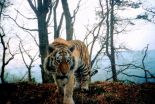Gut bacteria: How genes determine the fit of your jeans
2014-11-06
(Press-News.org) Our genetic makeup influences whether we are fat or thin by shaping which types of microbes thrive in our body, according to a Cornell-led study published today in the journal Cell.
By studying pairs of twins, researchers identified the Christensenellaceae bacterial family, which is highly heritable and more common in lean individuals. Moreover, a member of this class of bacteria, Christensenellaceae minuta, protected against weight gain when transplanted into mice.
The findings pave the way for personalized probiotic therapies that are optimized to reduce the risk of obesity-related diseases based on an individual's genetic makeup.
"If you look across the population of gut bacteria and explain abundances, there is a host genetic component," said Ruth Ley, associate professor of microbiology and the paper's senior author. "Up until now there had been no direct evidence that anything in the human gut is under that kind of genetic influence."
Genetic data that included 171 identical and 245 fraternal twins, whose genomes have been sequenced at King's College in London and are stored in its "TwinsUK" registry, gave them the power to answer questions and rank which microbes in the human gut are heritable, Ley said.
With twins raised in the same households, "you can assume that environmental influences are going to be very similar to one another," said Julia Goodrich, a graduate student and National Science Foundation Graduate Research Fellow in Ley's lab and the paper's first author. When Goodrich analyzed the microbe populations in the twins' fecal samples, she found that identical twins, who have the same genetic makeup, had more similar gut microbiotas to each other than did fraternal twins, who share half the same genes.
INFORMATION:
Co-authors include Andrew Clark, Cornell professor of population genetics, and Timothy Spector, a professor of epidemiology at King's College, among others.
The study was funded by the National Institutes of Health, the Cornell Center for Comparative Population Genomics, the Wellcome Trust and the European Community's Seventh Framework Programme.
ELSE PRESS RELEASES FROM THIS DATE:
2014-11-06
Along with the pressures of habitat loss, poaching and depletion of prey species, a new threat to tiger populations in the wild has surfaced in the form of disease, specifically, canine distemper virus (CDV). According to a new study from the Wildlife Conservation Society (WCS) and its partners, CDV has the potential to be a significant driver in pushing the animals toward extinction.
While CDV has recently been shown to lead to the deaths of individual tigers, its long-term impacts on tiger populations had never before been studied.
The authors evaluated these impacts ...
2014-11-06
NEW YORK, NY (November 6, 2014) --The most in-dept survey of its kind found that arm pain is common among supposedly healthy young baseball players and nearly half have been encouraged to keep playing despite arm pain. The findings suggest that more detailed and individualized screening is needed to prevent overuse injury in young ballplayers. The study, led by Columbia University Medical Center (CUMC) researchers, was published this week in the online edition of the American Journal of Sports Medicine.
"Both nationally and internationally, we're witnessing a troubling ...
2014-11-06
In a paper published by PLOS ONE, researchers concluded that a national strategy must be implemented in order to compensate for environmental damage caused by development projects in Africa.
Studying these issues and other serious ethical concerns, the research discovered that current offset programs - which are planned and designed on a project-by-project basis - fail to take into account the cumulative impacts of various conservations projects taking place in the same country or region.
The scientists from the universities of California, Stirling and Kent alongside ...
2014-11-06
This news release is available in German.
All multicellular creatures are descended from single-celled organisms. The leap from unicellularity to multicellularity is possible only if the originally independent cells collaborate. So-called cheating cells that exploit the cooperation of others are considered a major obstacle. Scientists at the Max Planck Institute for Evolutionary Biology in Plön, Germany, together with researchers from New Zealand and the USA, have observed in real time the evolution of simple self-reproducing groups of cells from previously ...
2014-11-06
ANN ARBOR, Mich. -- Teens and young adults who get seriously injured in an assault are nearly twice as likely as their peers to end up back in the emergency room for a violent injury within the next two years, a new University of Michigan Injury Center study finds.
The researchers call this repeating pattern of violent injury a reoccurring disease, but their landmark study also suggests potentially powerful opportunities to intervene in ways that could stop the cycle.
The first six months after a young person seeks care for a violence-related injury is an especially ...
2014-11-06
New Rochelle, NY, November 6, 2014--Lower-cost 3D printers for the consumer market offer only a limited selection of plastic materials, while industrial additive manufacturing (AM) machines can print parts made of high-performance metals. The application of a novel process called Selective Inhibition Sintering (SIS) in a consumer-priced metal AM machine is described in an article in 3D Printing and Additive Manufacturing, a peer-reviewed journal from Mary Ann Liebert, Inc., publishers. The article is available free on the 3D Printing and Additive Manufacturing website until ...
2014-11-06
Does synthetic biology hold the key to manned space exploration of Mars and the Moon? Berkeley Lab researchers have used synthetic biology to produce an inexpensive and reliable microbial-based alternative to the world's most effective anti-malaria drug, and to develop clean, green and sustainable alternatives to gasoline, diesel and jet fuels. In the future, synthetic biology could also be used to make manned space missions more practical.
"Not only does synthetic biology promise to make the travel to extraterrestrial locations more practical and bearable, it could also ...
2014-11-06
Berlin, Germany (November, 2014) - The dodo is among the most famous extinct creatures, and a poster child for human-caused extinction events. Despite its notoriety, and the fact that the species was alive during recorded human history, little is actually known about how this animal lived, looked, and behaved. A new study of the only known complete skeleton from a single bird takes advantage of modern 3-D laser scanning technology to open a new window into the life of this famous extinct bird. The study was presented at the 74th Annual Meeting of the Society of Vertebrate ...
2014-11-06
Berlin, Germany (November, 2014) - Many large charismatic mammals went extinct at the end of the Ice Age (approx 11,000 years ago), including the Steppe bison, Bison priscus. A recent find in Eastern Siberia has uncovered one of these bison, literally, frozen in time.
The most complete frozen mummy of the Steppe bison yet known, dated to 9,300 years before present, was recently uncovered in the Yana-Indigirka Lowland and a necropsy was performed to learn about how this animal lived and died at the end of the Ice Age. The Yukagir bison mummy, as it is named, has a complete ...
2014-11-06
There is no doubt that pregnant and breastfeeding women try to do everything they can to ensure a healthy outcome for their baby, including eating a healthy, well-balanced diet that provides the necessary nutrients for fetal growth and development. In recent years, there has been significant debate about the consumption of fish among pregnant and breastfeeding women.
In June, following a survey that found that the majority of pregnant women do not eat much fish and thus may have inadequate intake of certain omega 3 fatty acids, the Food and Drug Administration (FDA) ...
LAST 30 PRESS RELEASES:
[Press-News.org] Gut bacteria: How genes determine the fit of your jeans



